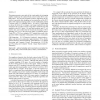Free Online Productivity Tools
i2Speak
i2Symbol
i2OCR
iTex2Img
iWeb2Print
iWeb2Shot
i2Type
iPdf2Split
iPdf2Merge
i2Bopomofo
i2Arabic
i2Style
i2Image
i2PDF
iLatex2Rtf
Sci2ools
GRAPHICSINTERFACE
2007
2007
On visual quality of optimal 3D sampling and reconstruction
This paper presents a user study of the visual quality of an imaging pipeline employing the optimal body-centered cubic (BCC) sampling lattice. We provide perceptual evidence supporting the theoretical expectation that sampling and reconstruction on the BCC lattice offer superior imaging quality over the traditionally popular Cartesian cubic (CC) sampling lattice. We asked 12 participants to choose the better of two images: one image rendered from data sampled on the CC lattice and one image that is rendered from data sampled on the BCC lattice. We used both synthetic and CT volumetric data, and confirm that the theoretical advantages of BCC sampling carry over to the perceived quality of rendered images. Using 25% to 35% fewer samples, BCC sampled data result in images that exhibit comparable visual quality to their CC counterparts.
| Added | 29 Oct 2010 |
| Updated | 29 Oct 2010 |
| Type | Conference |
| Year | 2007 |
| Where | GRAPHICSINTERFACE |
| Authors | Tai Meng, Benjamin Smith 0002, Alireza Entezari, Arthur E. Kirkpatrick, Daniel Weiskopf, Leila Kalantari, Torsten Möller |
Comments (0)

